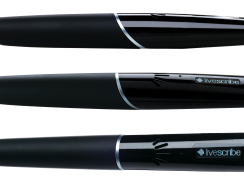
(AP) NEW YORK — Here’s a consumer electronics riddle: What’s the opposite of the iPad?
Answer: the Livescribe Echo “smartpen.” It’s as if Livescribe and Apple both looked at the old pen-and-pad combination, but completely disagreed on how to take it into the digital age.
Apple put all the smarts into the pad. Livescribe put all the smarts in the pen.
I don’t have to tell you which is the better idea — iPad sales have helped make Apple Inc. the most valuable company in the world. Livescribe is tiny.
But the Echo is interesting enough to be worth a look, particularly with some recent software updates. It starts at $100, making it more affordable than the iPad, and it could be a good tool for a student.
The Echo is a fat, cigar-like pen with a small screen near the top. It works as a regular ball-point pen, leaving ink marks on paper. But its reason for being is that it records what you write, and its microphone records what you’re hearing at the same time.
It matches up the audio recording with the recorded writing, so that if you tap the pen on something you’ve already written, it will play back the audio recording, either through its built-in speaker or through headphones. This is useful in almost any situation where you want to record something for future reference, be it a lecture or an interview.
Certainly, you can do the same thing on the iPad, with apps that match up audio and writing. But writing on the iPad isn’t easy. Styluses are awkward, and typing on the screen is not much better. You can use a PC instead — Microsoft’s excellent OneNote application records audio and typing — but you need to sit down to use a PC, and their microphones can be iffy.
So, the Echo is still the best tool for note-taking, particularly when you’re standing or when hammering away at a PC would seem rude, like in a meeting. I used Livescribe’s earlier model, the Pulse, quite a bit in my reporting job, and found the ability to tap back into a conversation to get a verbatim quote useful on several occasions. (In the old days, reporters used to learn shorthand. Today, we scribble furiously.)
The Echo improves on the Pulse by replacing proprietary audio and data ports with a standard headphone and micro-USB port. The USB port also charges the pen.
On the software side, the pen now “talks” better to other programs. For instance, you can mark pages and have them sent in an email as soon as you connect your pen to your computer. You can also send them to Google Docs, for sharing, or to OneNote, to keep your notes tidy. You can also post them on Facebook, perhaps for sharing lecture notes with friends. The writing looks good on screen — much better than it would look if you simply wrote on a pad, then scanned or photographed it.
There’s also an “app store” where you can buy little programs to download to the pen. One lets you measure the distance between two points on the pad, or compute the area of an enclosed space.
The coolest app, by far, is a version of the classic text-based adventure game “Zork.” It’s a pretty magical experience to write commands like “go north” and see replies like “You are in a clearing …” scroll by on the pen’s screen.
Another app lets the pen control your PC’s cursor when connected by cable. Hover over the pad, and the cursor moves. Press down, and you register a click, or draw on the screen. It’s equivalent to Wacom’s PC input tablets, but it doesn’t register different degrees of pressure, so it’s unlikely to be useful to artists.
Speaking of pads, you do need a special pad to use the Echo. It works only on paper that’s preprinted with a pattern of dots that looks like a faint speckling of the page. The dots are picked up by a small camera in the pen and allow it to figure out where it is on a page. You can buy a four-pack of additional notebooks from the site for $19.95 (one small notebook comes with the pen). It’s also possible to print your own dotted paper if you have a color laser printer.
The biggest drawback to the pen is its tiny screen. It’s not that hard to control this “pen computer” — you write things, and it responds. But it has a really hard time communicating anything back, since its screen shows less than 25 characters at time, in monochrome. It can also talk to you through its little speaker, but that’s not a medium that can convey the complexity of a Web page. Even a phone screen can communicate a lot more.
The other big shortcoming is that the pen needs to be physically connected to your computer to send email, upload notes or control your cursor. A short-range wireless link like Bluetooth would be neat, but might not be fast enough to transfer notes. Wi-Fi would be better, but getting a pen to work well with Wi-Fi would be a big challenge, both in terms of the user interface and battery life.
I like the Livescribe pens and find them useful. But as computers, they are a dead end. They’re just not flexible enough to be general-purpose devices, like tablets. An iPad that worked well with pen input would make me drop the Echo. Apple’s competitors already have rudimentary pen-based tablets out, and who knows, maybe the iPad 3 will have some surprises for us.
___
Article by: Peter Svensson can be reached at http://twitter.com/petersvensson